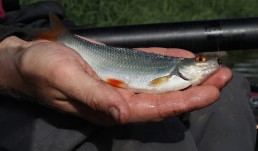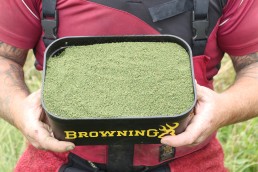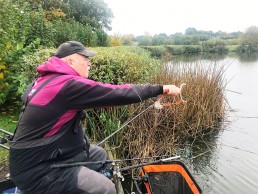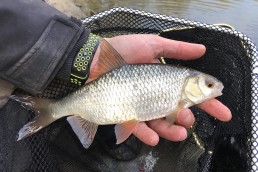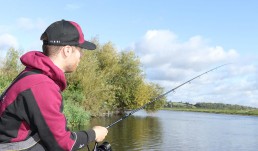A Day After Dace
The first day of my mini break to Herefordshire to fish the beautiful river Wye coincided with a wet weather front and a quick glance at the river the night before saw it at least sixteen feet high, however we had been expertly informed that it was dropping fast and would be fining down nicely the following morning.
Catching at a quicker rate
As promised it was and everything looked perfect to set up two lines of attack. The first being my new Sphere Silverlite System Whip aimed at fishing 8m to hand in a depth of around 7’ of water. My second line of attack was my trusted Sphere 14’ Match Rod teamed up with a Sphere MgTi 940 reel loaded with 4.5lb Black Magic Gold Mono along with a 4.5g Scott Douglass bolo float that would be run down the inside crease. Both the whip and bolo would be fished on the same line, the whip enabling me to catch at a quicker rate to hand, with the bolo giving me the option to search the bottom of the swim should the fish drop down the peg.
Gauging the response
Feed would be hemp and caster in generous quantities with a single caster on the hook in an attempt to avoid the millions of bleak that also seem to be thriving in the river. I mixed together two bags of Browning Champion’s Choice River and two bags of Black Magic groundbait but decided not to feed this from the off and gauge the response of the loose feed in an attempt not to attract the bleak.
Searching the peg
I decided to start on the bolo float to search the peg, this was set with a 4g olivette as the bulk with three no8 shot directly under the olivette and two no8 set four inches apart above an eight inch hook length of 0.16mm Cenex Hybrid Power Mono with a size 14 Sphere Match hook finishing the set up. This setup looked and acted perfectly in the crease which was about 8m from the bank. The first hour was hectic with the dace and roach responding to the hemp and caster loose feed, a nice run of quality roach up to 1lb from the inside glide preceded until the flow started to ease with the river continuing to drop.
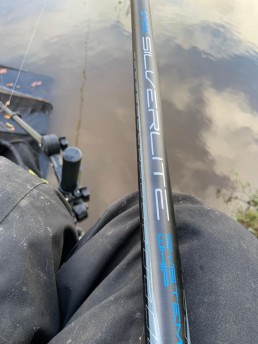
The Sphere Silverlite Whip System was made for this type of fishing.
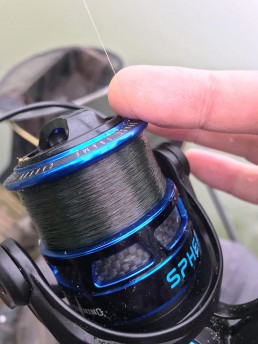
I started on the running line Bolo rig to locate the shoals of fish.

Feed maggots mixed with groundbait to get the bait down quickly and concentrate the dace shoals.
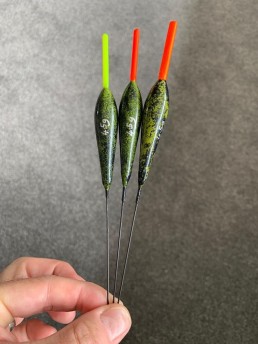
A medium-weight Bolo rig enables me to search the peg to begin with.
"The dace fishing here is incredible."
Far greater control
This marked the time to move on to the 8m whip line which gave me far greater control and enabled me to fish a lighter float of 3g, a slim line pattern was used to enable me to both run through and hold back the float at different intervals to entice a bite. The rig was set at 8m to hand on 0.16mm Hybrid Power Mono to a 0.14mm six inch hook length of the same material and once again a size 14 Sphere Match Hook completing the set up. This was my first outing with the Sphere Silverlite Whip and something I had been rather looking forward to giving a run out for some time. Due to the size and strength of the fish in the Wye I decided to use the hollow top kit and had elasticated the top section with a short length of Browning yellow 2.10mm Stretch 7 Elastic which has a rating of 8+, perfect for both providing a cushion on the strike and enabling me to swing dace up to 8oz to hand.
It’s fair to say the dace were queuing up on this line and the superior presentation that the whip provided enabled me to end the session with over 30lb of prime fit river Wye dace and roach.
Tim Bruce

I run Stretch 7 yellow elastic through the hollow tip of my whip in case of bonus fish.
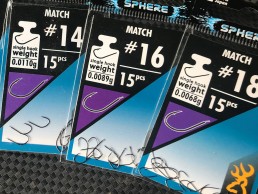
Sphere Match hooks are perfect as they keep their points no matter how many fish you catch.
Tim’s Tackle
Sphere Silverlite System Whip
3g Float
0.16/0.14mm Cenex Hybrid Mono Line
Sphere size 14 Match Hook
Stretch 7 Elastic
Sphere 14’ Match Rod
Sphere MgTi 940 Reel
4.5g Scott Douglas Bolo Float
4.5lb Black Magic Gold Main Line
4g Olivette
0.16mm Cenex Hybrid Power Hook Length
Sphere size 14 Match Hook
Tim’s Bait
Hemp
Caster
Champion’s Choice Black Magic and River Groundbait
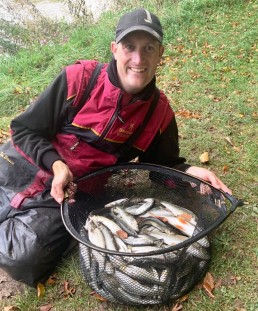
Tim displays his cracking Wye catch of silvers.
Chalk Stream Trotting
I love the competitive nature of match fishing and the banter on the bank, yet there are times when I need to get away from it all, go back to the days off old and just chill and if I can catch a few fish whilst doing so then all the better.
In the deep end
Fortunately living in Berkshire I have numerous chalk streams that flow across the county and if you look hard enough you will find the odd free stretch. These are usually clear and shallow and to get the best from them it’s a case of getting my Black Magic thigh waders on and literally getting in! Travelling light with just a float rod, landing net and bucket containing bait and a small amount of spare terminal tackle is all that’s required and as I wade downstream it’s simply a case of introducing some bait, trotting through a few times, catching some fish before moving on. These free stretches often pass through urban areas, yet by getting in the water you soon forget about the ‘hustle and bustle’ around and drift into a world of your own, right back at one with the natural world around, great for relaxing the mind, if not the body.
Traditional trotting float
The tackle I take on these short roving sessions consists of my old and trusted Browning 13ft Ultra Light Legend float rod teamed up with a Sphere MgTi 920 reel loaded with 0.14mm Cenex Classic Mono. The rig is kept simple, just a traditional trotting float cocked with a 3g olivette and the hook length, which is created from Cenex 0.13mm Fluoro Carbon, has a single small dropper shot placed on it before finishing it off with a Sphere Match size 16 micro barbed hook.
A grain or two
Usually all that’s required for bait, especially after the first frosts is a pint of maggots but today I’ve bought along some grains of sweetcorn as its early autumn and the minnows might just be a problem. A bait pouch is also an invaluable piece of kit as it allows me to feed effortlessly as is a disgorger that I hang on a piece of string around my neck and a peaked cap to block out and sunlight.
The colder, the better
Today’s two hour session has produced plenty of fish including some cracking dace, grayling to over a pound plus one small trout and plenty of minnows that just seem to feed harder the more maggots that are fed so the sweetcorn did come into play in some swims. The bigger fish that move into these urban areas in the depth of winter and still to arrive and this style of fishing will just get better and better the colder it gets. If you want to clear the mind and catch plenty of fish this coming winter then it might be worth looking close to home as many tiny streams can produce more fish than you realise.
Justin Watkins
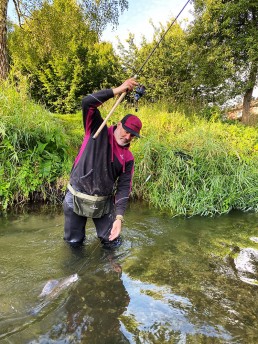
Standing in the clear water it really doesn’t get much better than this.
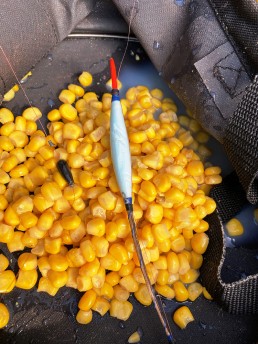
Simple baits, such as maggots and corn, are ideal for this type of fishing.

Grayling are often abundant in these small streams.
"You only need the minimum of tackle for this style of fishing."
Justin’s Tackle
13’ Ultra Light Legend Float Rod
Sphere MgTi 920 Reel
Cenex 0.14mm Classic Mono
Cenex 0.13mm Fluoro Carbon Hook Line
Sphere Match size 16 Hook
3g Float
Justin’s Bait
Red & White Maggots
Sweetcorn

Use quality lines and don’t be tempted to fish too light. Fluorocarbon is brilliant for hook lengths in the clear water.
Rig it Right - Hydrus Metal Method Feeder
The Method feeder is a brilliant way of catching carp, F1’s and bream all year round. Simple to tie, tangle-free and deadly accurate, this is a set-up that you definitely need in your armoury.
Many commercial fisheries insist that all Method feeder rigs should be free-running, so that if a rig should be lost there is little chance of a fish being left towing a feeder around. Although it might appear that a running Method will create less of a bolt-effect, in practice it works really well and is just as effective as a semi-fixed feeder.
One thing to bear in mind is to use strong hooks and lines when Method feeder fishing. Not only are you likely to encounter some big fish, but constant recasting with loaded feeders can be quite a strain on the main line in particular. Bites are also often very savage, and once again, this will soon reveal any weaknesses in your rigs.
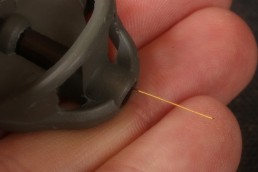
- Thread the Hydrus Method feeder onto the main line.
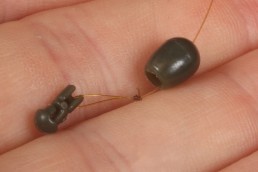
2. Tie a Quick Change Bead to the end of the main line using a figure-of-eight knot.
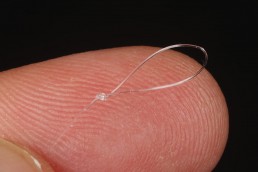
3. Tie a small over-hand loop in the end of a 25cm length of the Hybrid Mono hooklength line.
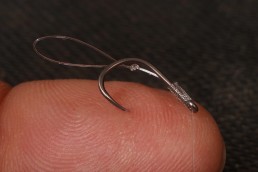
4. Tie on a size 12 Sphere Beast eyed barbless hook using a 12-turn knotless knot.
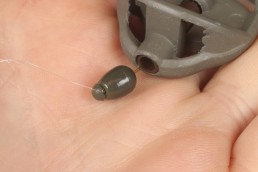
5. Tie a small figure-of-eight loop knot in the end of the hooklength, which should be around 12-15cm in length. Attach it to the Connector Bead.

6. The finished rig should look like this. You can use a small wafter, boilie, pellet or punched meat on the hair as a hookbait. Load the feeder with Method groundbait or soft pellets.
"The running Method is a very effective rig for commercial fisheries."
COMPONENTS
0.20mm Method Mono main line
0.16mm Hybrid Power Hooklength line.
Size 12 Sphere Beast Barbless Eyed Hook
30gram Hydrus Method Feeder
Medium Connector Bead
Hair Stops
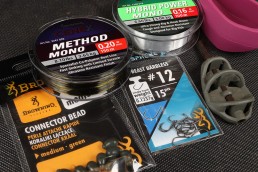
Plunder Trent Silvers on the Pole
Originally Published in English
The middle to lower river Trent is booming at the moment with huge numbers of silver fish to be caught in many areas. One of the great things about the river at the moment is that you can pick and choose your tactics based on the peg that you are fishing. Generally speaking, the more depth and flow that you have close in the better a peg will respond to float tactics, whether that be running a stick float through, fishing a Bolo, or on the pole line that I will be fishing today. I wouldn’t say that todays peg is perfect for the pole, the deepest part of the river is further out, but for a great days fishing you can’t really beat the precision of the pole, and it is just such a lovely way to fish.
I am on a peg at Burton Joyce today, which is pretty typical of the Trent around Nottingham. The main species to aim for are roach and dace, with a few perch thrown in for good measure. There is also the chance of a bigger bonus fish, particularly chub, but you can’t count on these. The rocky banks slope away quite steeply, and once you get past the weedy margins the depth levels out at about 2.5 metres by 13 metres. I will start off at this distance, as it gives me somewhere to go if the fish start to back off.
KICK OFF WITH GROUNDBAIT
I am not intending to start on the pole line, but I will introduce a little patch of feed that the fish will hopefully settle over and gain confidence, ready for when I want to use this line. With the hemp fishing in particular, the longer that you can leave the fish to settle the more confident they will be and the more bites you will hit.
I’ve made up some really dark groundbait using the Champion’s Choice Black Magic and Champion’s Feeder Black Roach mixed 50-50. To being with, I will introduce two decent-sized balls of this mix, laced with some hemp and casters. I’ve compressed the balls fairly hard to get the groundbait down to the bottom before it starts to break up as I want it to act as a focal point in the swim.

Feed a pinch of casters twice every run through.

Feed hemp, but don’t be in too much of a hurry to switch to it as a hook bait.
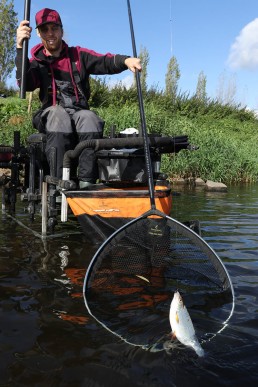
You can expect some cracking roach to show up on the Trent.
ADJUSTABLE RIGS
I am going to aim to catch fish by slowly running the float down the peg. A good starting pace is about half the speed of the surface, as this helps to keep the hookbait running in front of the line, and better matches the flow close to the bottom. Holding back slightly harder will cause the bait to rise off the bottom slightly and almost stop, often conjuring up an extra bite.
My rigs are pretty straight forward and are designed to enable me to control the fall of the bait. Floats are a Chianti-style pattern that have a slim profile which cuts through the water perfectly and carry 4×14, split into no.10 shot spaced at 6cm intervals. By breaking up the shot I can adjust the fall of the bait. Bulking the shot up to get the bait down faster, especially if bleak in the upper layers are a problem, or spreading them out to give a more natural presentation.
The rigs are made up on 0.14mm diameter Cenex Hybrid Power line, to a 0.12mm hooklength, terminating in a size 18 Sphere Match hook. Make sure you bury most of the caster inside the hook as this will bring more bites from the roach, especially when the water is clear.
For this style of fishing I run solid no.6 elastic through the top kit of my Xitan Z16-L Advance pole. I have fitted a puller kit just in case I hook a bonus fish as this will enable me to tension the elastic quickly, giving me more control.
BAITS
With roach being my main target on this line I am going to feed a small pinch of caster and hemp twice each run through. Because of the bleak, which can be a right pain on some pegs, I will avoid feeding maggots. The casters sink a little faster, and being dark are less likely to be picked off by the bleak.
The hemp is an obvious choice for roach, both as a feed, and if the fish get on it later in the session, as a hookbait too. Once the roach are confident on the hemp the average size of the fish will definitely be a bit bigger than with the casters, but it can take a few hours for them to get enough confidence to take it well. Go on to the hemp too early and you will either get less bites, or fat bites that are difficult to hit.
I have some maggots with me as well, and these will come into play as another change hookbait should the bites on caster slow down. With regular feeding though I would expect the fishing to get better for at least the first couple of hours, before I need to make any changes.
IT DOESN’T TAKE LONG
This morning I have started on the feeder, fishing half-way across the river, for a couple of hours before dropping back onto the pole line. I have kept feeding the float line the whole time with a pinch of casters and hemp every couple of minutes and I’ve not noticed too many bleak swirling on the surface, which is a good sign. I’ve been busy catching a decent dace almost every cast on the feeder, and it is easy to forget to feed the pole line, when you are as busy as this, but it is essential to keep the bait going in to build up this line.
I could have stayed on the feeder, but as I am practicing today, I force myself to put the rod down and pick up the pole. First run through, with the rig plumbed to have the bait just tripping along the bottom, the float only moves about a metre before it pulls under confidently. Roach number one is soon in the net – a good start.
With a slight upstream wind today presentation is pretty good and I am able to edge the float down the peg at whatever speed I choose. Soon I find the area where most of the bites are coming and I slow the rig down a touch when it gets to this spot. The roach vary in size, from a couple of ounces, up to about half a pound, lovely sport, only partially spoilt by a big pike that has taken up residence right in front of me!
I suspect there could be more predators about, as the bites start to become a bit more sporadic after the first hour, which often happens if there is a big fish down there spooking the roach. The fish have kept coming though and a switch to hemp has made a difference too, with the fish getting noticeably bigger. The bites are really positive too, and despite me fishing with quite a long line on a top-four kit, so that I can run teh rig down the swim, I’m not missing many indications.
The great thing with the Trent is that you can catch on so many different methods, with each peg being different. I must say though that for a really nice days sport nothing beats running a float through on the pole for me. These tactics will work equally well on other large rivers with a bit of flow too. Give it a try, you won’t be disappointed.
Tom Noton
Browning Hot Rods

I use a slimline 4×14 float unless the conditions are really blustery, or the flow very strong.

Strung out no.10 shot allow me to adjust the fall of the bait through the water column.

Don’t fish with too short a line. I like to be able to run the float down the peg and search for extra bites.
"Switching to hemp will bring a better stamp of fish."
Tom’s Tackle
Xitan Z16-L Advance Pole
Cenex Hybrid Power 0.14mm rig line
Cenex Hybrid Power 0.12mm hooklength
Sphere Match Size 18 Hook
4×14 Chianti Pole float
Tom’s Bait
Two pints of casters
Two pints of hemp
One pint of maggots
One bag Champion’s Choice Black Magic
One bag of Champion’s Feeder Black Roach
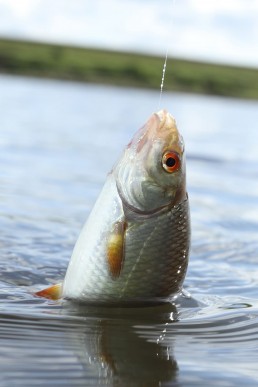
The river Trent has some brilliant silverfish sport.
How to Mix the Champions Method Mussel Green Groundbait
Originally Published in English
The Champions Method Mussel Green Groundbait has quickly become one of my favourites and I have found it equally effective when used for bream as it is for carp. Like most Method groundbaits, it has quite a high fishmeal content, but also contains mussel additives that fish really love. Let’s take a look at how I mix it to the perfect consistency every time. It’s a good idea to make mixing groundbaoit the first thing you do when you arrive at your peg – by the time you’ve sorted everything else out it should have soaked up enough water and will be ready to fish with.
Whilst you can combine this groundbait with others, I find it works great on its own. A bag of groundbait is ideal for a days Method fishing.
Chris Wright
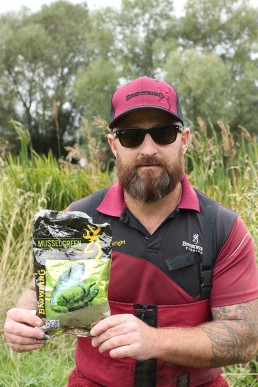
Whilst you can combine this groundbait with others, I find it works great on its own. A bag of groundbait is ideal for a days Method fishing.
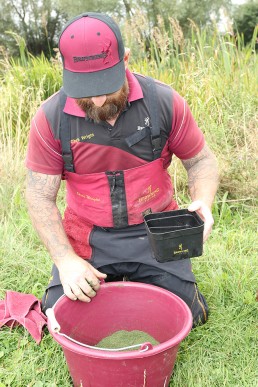
Add lake water slowly to the dry groundbait. As with all groundbaits, don’t be tempted to use too much water all at once.
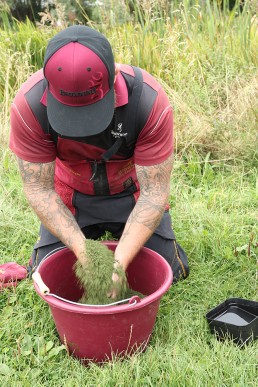
Keep the groundbait moving and mixing all of the time, this will help avoid lumps.
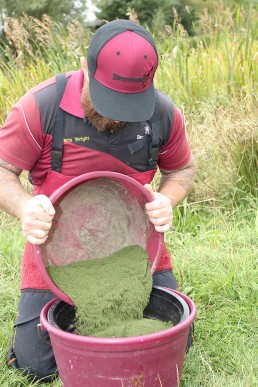
Once you are happy with the consistency of the groundbait leave it for a minimum of ten minutes and then pour it onto a maggot riddle.
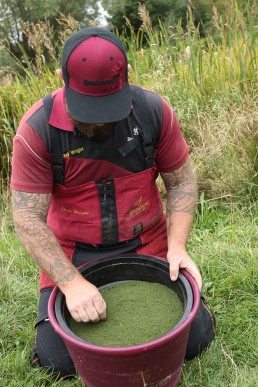
Riddle the groundbait to help break down any lumps and also to further mix the groundbait to a finished consistency.

The finished groundbait binds well, ideal for the Method feeder, and breaks down quickly, releasing those fish-attracting flavours.
Catch Carp on the Slow-Sinking Feeder
One of my favourite venues, Watmore Farm Fishery in Surrey is full of carp, gin clear and responds all year round to the pellet waggler, however this venue is deep, over 20ft in places and searching out every inch of its depth is just impossible on the float. As the colder weather sets in the carp tend to drop lower in the water and it takes longer to tempt them up into waggler territory. Many start on the pole for the silver, constantly catapulting 8mm pellets on the waggler line whilst doing so, yet a few hours catching 10lb of silvers then carp later on in the match rarely will win a match here. Heading straight out on the bomb and fishing a slow sinking pellet on a long hook length is an option and once again does score but a tactic that I have had up my sleeve for a while now and one that has kept fellow anglers wondering how I seem to catch consistently throughout a match is the Slow Sinking Feeder.
A deadly method
I’ve come back to Watmore Farm to demonstrate this deadly method and have set up in Peg 7, not the deepest area but one that offers a good fifteen feet at 8mm pellet catapulting range, around twenty-five yards. There are a few carp anglers around and to my knowledge they haven’t had a great deal of luck throughout the night; however a few fish are showing so this is encouraging.
An absolute innovation
My set up consists of a Sphere Pellet Waggler rod teamed up with a Sphere MgTi 940 reel loaded with 0.22mm Cenex Low Stretch Mono. Placed onto the mainline first are a couple of Xitan Oval Super Stopper’s then a Quick Change Swivel which is trapped between yet another Oval Stopper. Onto the Quick Change Swivel is the feeder which is a Xenos J-25 with the Slow Sinking head screwed in. These feeders are brilliant as they allow different weighted heads to be quickly added or in this case the floating head device to be attached. This floating head can be used to target carp on the surface as it floats but it has a small opening and a plug which allows small shot to be added allowing the speed of decent to be adjusted from critically balanced and very slow sinking to a quicker speed of decent dependent of weight added. It’s an absolute innovation in commercial carp feeder fishing as it allows every inch of a swim to be explored. Last to be attached is a size 14 barbless 0.18mm Feeder Method hook-to-nylon which contains a pellet band into which an 8mm slow sinking carp pellet will be added.

My edge revealed, the Slow Sinking Feeder.

A few small split shot will sink the feeder slowly.
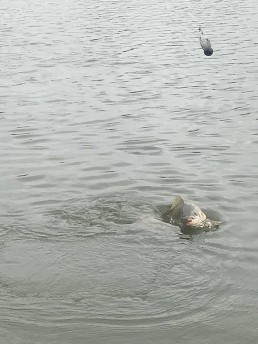
First cast and we are away.
"Often the carp will be in midwater at this time of the year."

Feather the line as the feeder hits the surface.
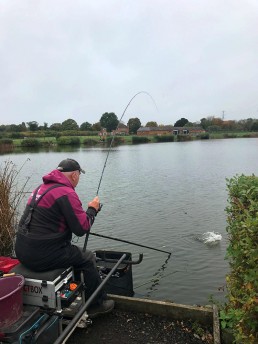
The carp at Watmore Farm Fishery respond well to this method.
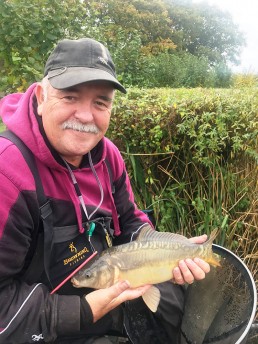
Not the biggest, but off to a great start.
How and where they want it
Although the set up is very simple you will still need to play around with the length of the hook link as sometimes they will want the bait close to the descending feeder and at other times well away so it’s important to keep adjusting this to find what’s best. Something else that is paramount is finding at what depth they are intercepting the bait so as soon as the feeder hits the surface I start to count. The feeder today takes a good twenty seconds to hit bottom so there’s no point in leaving it there any longer if most of the bites are coming after say ten seconds. It’s just a case of working where and how they want it then casting accordingly. Effort equals reward and just like the pellet waggler the more you put into a session the more you will catch.
Waiting for the tip to be dragged round
Feeding on a little-and-often basis is paramount and again you will need to find out how many pellets to introduce and how often to do this. In the summer feeding ten pellets every twenty seconds maybe needed, yet in the depth of winter one or two every couple of minute might be best. Today I’m feeding six every thirty seconds and have been doing so since arriving and whilst setting up, some twenty minutes ago. Pinpoint accuracy isn’t needed, you just have to make sure that the catapulted pellets are entering the water in quite a tight area and that you cast the feeder to the same spot. I fill the feeder simply by adding around eight 8mm pellets then plugging, like you would with a spod, with some micro pellet or dampened down groundbait. Once the feeder lands it’s simply a case of placing the rod across my knee and onto the rest and waiting for the tip to be dragged round which has happened on my very first cast!
An hour in and nine carp averaging 6lb have graced my net so you can see how well over 100lb of carp can be caught in a very short space of time and just what an edge this little innovative device has given me.
Colin Sheppard

The Slow-sinking feeder (centre) has an adjustable float instead of a lead.
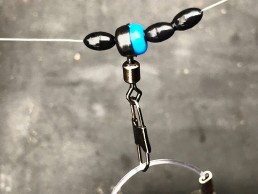
Locked in position by Oval Super Stoppers but easily adjusted.
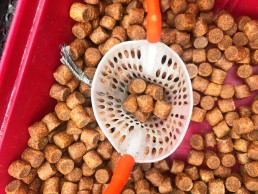
Six to eight slow sinkers fired in every thirty seconds.
Colin’s Tackle
Sphere Pellet Waggler rod
Sphere MgTi 940 Reel
Xenos J-25 Slow Sinking Feeder
Feeder Method hook-to-nylon with pellet band – barbless size 14
Hook Length Cenex 0.20mm Hybrid Power Mono
Xitan Medium Super Stopper Oval
Quick Change Swivel
Colin’s Bait
8mm Low oil Carp Pellets
Micro Pellet
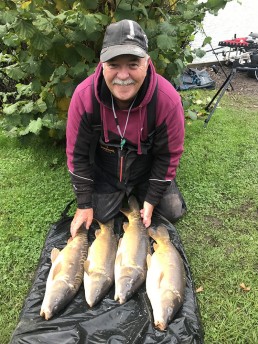
This is a brilliant tactic when the carp are sitting in mid-water.
Catch Roach on Pinkies
First Published in English.
If there’s two baits that I wouldn’t leave home without when targeting roach in the colder months on a venue that’s crystal clear then it has to be bread punch and pinkies. Today both are with me as I’m heading to a beautiful venue called Waggoners Wells, controlled by Grayshott Angling Club situated on the Surrey/Hampshire border. The Middle Lake here is deep, gin clear and contains loads of quality roach, great for punch which will be my first line of attack and if things don’t go to plan, then good old pinkies over a dark groundbait will come into play.
Back-up plan
I’m fishing off the dam where the water quickly shelves away to around nine feet at 10m and to say things aren’t going to plan after a couple of hours is an understatement as the roach are just not responding to the bread punch, a rarity here. It’s time to introduce a couple of balls of Champion’s Method Black Roach, a dark mix which is ideal for clear water, and within are a few pinkies, fed on a new line slightly to my right. This is left for around thirty-minutes whilst I persist on the punch line but although I do believe the roach will feed eventually on this line, I don’t have the luxury of staying all day and need to make it happen sooner rather than later.
Staggered shirt button
The rig I’ve made up for the pinkie line is created using Cenex 0.08mm and 0.14mm Classic Mono, a great all round line and hook length for pole rigs. A hook that I have recently started to use for most of my roach/skimmer fishing is the Sphere Ultra lite. It’s an extremely light and sharp hook with a fine gauge but still very strong and in this situation have opted for a size 18 onto which two pinkies will be impaled. I’ve decided to cock the 1g pole float using a staggered shirt button, starting at half depth with the first of twelve no9 soft shot which are spaced out so they get slightly further apart as they near the hook. This gives the hookbait a much more natural descend through the lower levels and have decided to fish at dead depth to start off with. Two important components when float fishing are a large plummet to initially find the depth of the swim and the other the use of soft split shot, as if the fish come up in the water and I need to adjust my shotting pattern I can easily move the shot on the line without causing any damage. The pole I’m using is a Xitan Z16 pole and as I’m not using this fully extended have pushed over the butt end one of the new Xitan EVA Pole Caps, the reason being, as although I’m using a roller, at the rear of me are some bushes and this cap simply protects the section and stops any annoying dirt or grit getting into the end section. I’ve also opted for the thinnest Microbore Poe Elastic available, the lime green 1.3mm and with a Pole Elastic Alignment Bush inside the topkit creates the smoothest elastic you could ever ask for, something very important when fishing for hard mouthed roach.
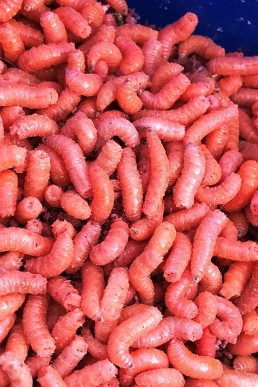
Fluoro pinkies, a must-have bait in the winter.
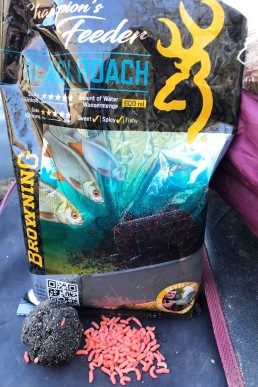
Black Roach, great in crystal clear water.
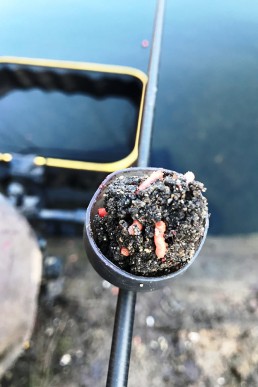
Start off with a small amount of groundbait and pinkies.
Switching the roach on
The roach are just not responding to the punch so it’s time to test the pinkie line and although bites aren’t instant finally one comes, yet it’s not my intended quarry but a small perch but at least it’s a bite. Fortunately this line just gets better and better as the session continues and by feeding a small ball of groundbait every twenty minutes plus a few pinkies fed through a pole cup every put in, keeps the bites coming and eventually the roach switch on. I have to admit that if the roach were in an obliging mood and responded to the punch straight away then I would have easily put together 25lb plus of sizable roach which usually average 10oz and do go to well over a pound but for some reason it just hasn’t happen today, however with 15lb of roach and perch taken in the last three hours, how can I be disappointed!
Stereotyped approach
Fishing in winter can be very unpredictable and this session just goes to show that if I had been stereotyped in my approach and come with just one bait, bread punch that nine times out of ten produces, would have on this occasion headed home with just a handful of fish, as I did from time to time try the punch line and although bites did finally come they were few and far between. Always have a back-up plan as one day you will need it!
Ken Russell
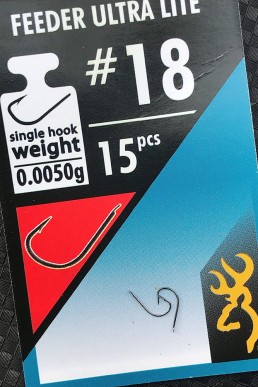
Light and sharp, just what’s needed when targeting shy biting roach.
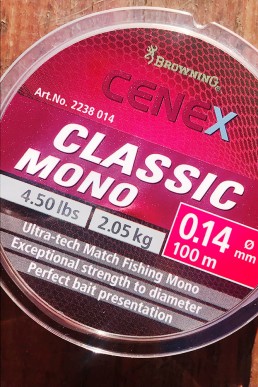
Classic Mono, great for pole rigs.
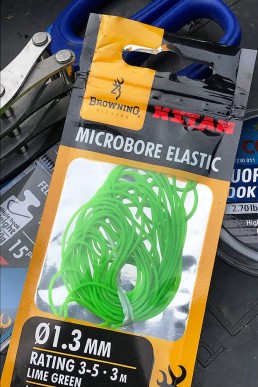
Microbore elastic offers major advantages over conventional elastics.
"Pinkies are such an effective winter bait"
Ken’s Tackle
Xitan Z16 L Advance Pole
Cenex 0.08m and 0.14 Classic Mono
Sphere Feeder Ultra Lite size 18 hook
Xitan Microbore 1.30mm Elastic
1g float
No 9 Soft Shot
Ken’s Bait
Champion’s Feeder Black Roach
Fluoro Pinkies

A brilliant result on a winters day.
Catch Dace on the Feeder
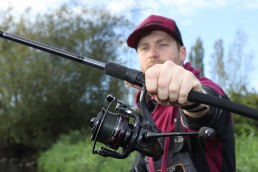
Use the right gear – a Sphere MH Feeder rod is combined with a Black Viper Compact reel.
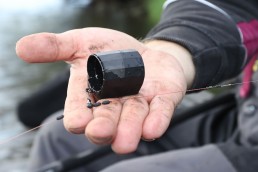
Wrap the cage feeder is tape to ensure the bait gets to the bottom.

Use a hooklength of around one metre long.
"Catching big weights is all about getting into a rhythm."
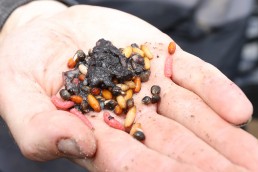
The feeder is loaded with a small amount of chopped worm and caster.
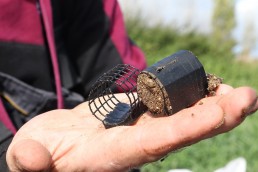
Use a feeder that is heavy enough to just hold bottom.
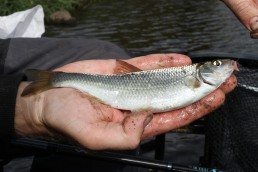
The dace here are of a great average size.
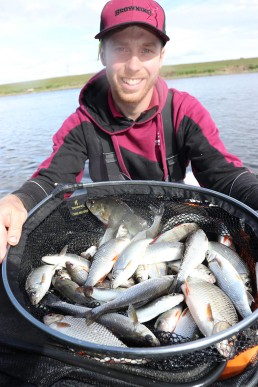
There is some brilliant sport to be had on the feeder.
How to Catch Silvers to Hand
First Published in English.
Every winter, more and more silver fish venues seem to be cropping up on my match schedule and it’s the anglers that are speed fishing for roach and skimmers to hand that seem to be dominating the top spots, so it was time to purchase Browning’s new Sphere Silverlite System Whip and put it through its paces.
Too big to swing
Having fished the flick tip to hand for roach and toughly enjoyed the experience earlier in the week it was time to head to another venue, one equally full of silvers, however with the chance of a carp or big bream barging in on the action I needed to elasticate one of the hollow top kits just in case. The venue, Lodge Pond controlled by Farnham Angling Society is teaming with silvers and after scratching around on the Kennet and Avon Canal the previous week I was looking forward to swinging in a fish hopefully every put in, however I knew sooner or later something a bit too big to swing would come along.
Into position
Tackle had to be thought through prior to the session so I decided to run Xitan1.9mm Microbore Pink, which has a 7-9 rating through the No 1 and 2 sections and fish at 6m to hand. The rig consisted on 1g Tamgi pole float, with the tip blackened out placed on a Cenex 0.16mm Hybrid Power Mono and cocked using a 0.6g inline olivette plus three No 8 and one No 11dropper shot that I’d placed on a short six inch 0.12mm Hybrid Power hooklink with a Sphere size 18 micro barbed Feeder Ultra Lite hook completing the set-up. I’d also added a single No 8 back shot above the float for extra stability. The reason for using a 1g float, even on this shallow venue, is that it can be swung out into position easily and is still delicate enough to show up the slightest of bites associated with skimmers.
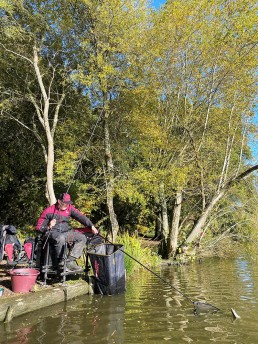
If they were like this every cast.

Microbore elastic, just in case.

Weight builders.
"Every drop in resulted in a bite within seconds"
Little and often
As for bait I’d bought along both casters and maggots, the casters intended to pick out the bigger fish if small fish became problematic on maggot plus a bag of Champion’s Feeder Quick Skimmer for obvious reasons. Three balls of groundbait, which had been run through a fine riddle a couple of times was introduced from the off with the intension of loose feeding maggots or casters every put in for the entirety of the short session.
Perfect performance
Straight away it was obvious that the swim contained loads of small roach that were just smashing the maggots to bits so immediately I switched to casters, slowly increasing the feed in the hope of drawing in some bigger roach and skimmers. Every drop in produced a bite within a couple of seconds and it wasn’t long before the elastic started to stretch from the tip as a small carp powered off but the pole coped with the situation perfectly and the first bonus fish was in the net. Even though the bigger roach and skimmers didn’t show in any great numbers I’d still put together a really enjoyable double figured bag in just a couple of hours and the Sphere Silverlite System Whip once again performed perfectly in every situation.
Justin Watkins

The perfect caster hook.
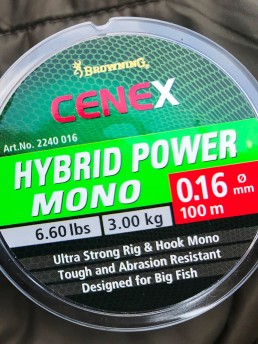
The perfect line for pole rigs.
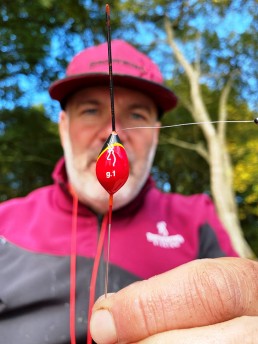
I’m glad I’ve still got a few of these.
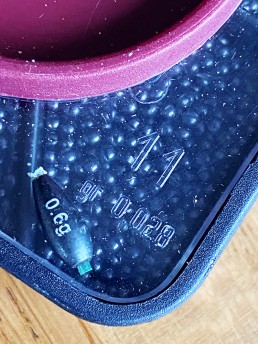
Inline olivette and tiny droppers.
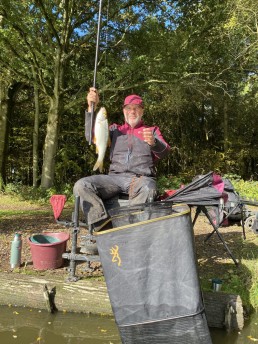
Getting in the rhythm.

Not bad for a quick two hour session.
Justin’s Tackle
Sphere Silverlite System Whip
Cenex 0.12mm & 0.16mm Hybrid Power Mono
Sphere size 18 Feeder Ultra Lite Hook
0.6g Inline Olivette and No8 & 11 Shot.
Xitan Pink1.9mm Microbore Elastic.
1g Tamgi Pole Float.
Justin’s Bait
Champion’s Feeder Quick Skimmer groundbait
Casters
Maggots
Mix a Roach Feeder Groundbait
The no.1 is a medium-fine groundbait that is the ideal base for the mix. Roach really like the taste of this groundbait and it can mixed from very dry so that it explodes out of the feeder, to slightly damper to bind it better. The Black Roach is a very dark groundbait loaded with spicy additives that roach love.
Chris Wright

Add the two bags of groundbait to a large mixing bowl with a flat bottom. A bowl like this makes mixing the groundbait much easier.
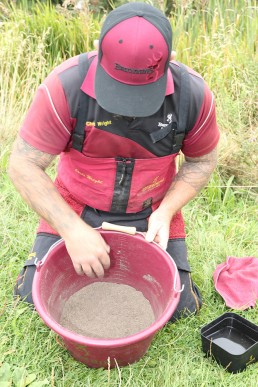
Thoroughly mix the two groundbaits together. This will help to avoid lumps and inconsistencies in the groundbait.
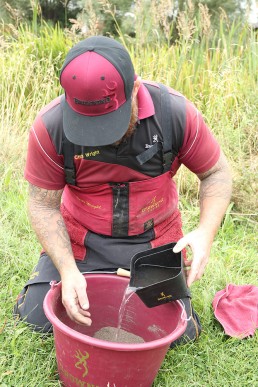
Slowly begin adding water to the dry groundbaits. Remember to take it easy as you can always add more water, but you cannot take it out.
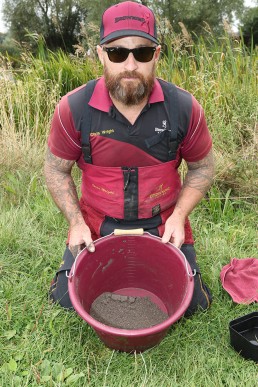
Because I am fishing with a Window feeder I keep the groundbait nice and dry so that it quickly breaks down once the feeder has settled.
"Use a mixture of Champions' Choice no. 1 and Champion's Feeder Black"
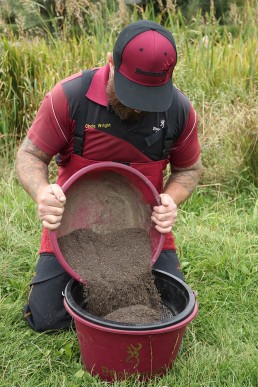
Use a maggot riddle to break down any lumps in the groundbait and to give it a fluffy consistency.
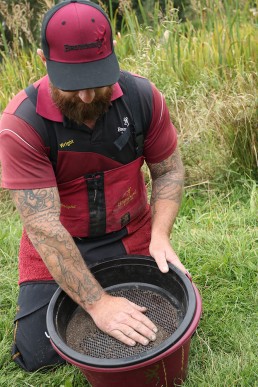
Don’t be tempted to push any lumps through the riddle. These will be too wet and sticky, so are best discarded.

The finished mix is nice and fine, perfect for filling the Window feeder. It will release plenty of attraction, but not fill the roach up.
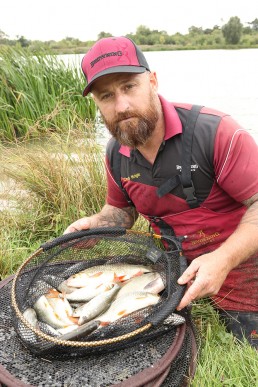
The result of a couple of hours fishing with the feeder and this groundbait mix.


